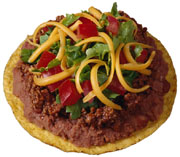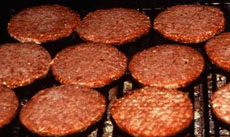 Prepared by
Prepared by
Diane Ball Linder, EdD, LDN, RD
Page 3 of 4
We get protein from both animal
and plant foods. During the Stone Age, our ancestors got most
of their protein from plants. Much later, our ancestors began
eating meat. Today, most of the protein we eat comes from animal
products.
|
|
Click here for the printable (Word) version of the lesson
Amino Acids
in Protein
 Proteins are made
up of amino acids. The kinds and amounts of amino acids in a
protein determine its nutritive value. We get protein from both
animal and plant foods. During the Stone Age, our ancestors got
most of their protein from plants. Much later, our ancestors
began eating meat. Today, most of the protein we eat comes from
animal products. Proteins are made
up of amino acids. The kinds and amounts of amino acids in a
protein determine its nutritive value. We get protein from both
animal and plant foods. During the Stone Age, our ancestors got
most of their protein from plants. Much later, our ancestors
began eating meat. Today, most of the protein we eat comes from
animal products.
Animal proteins, such as animal muscle (meats), milk and eggs,
can supply all of the amino acids in about the same proportions
in which they are needed by the body. These are rated as having
a high nutritive value. Animal proteins are considered high-quality
proteins or complete proteins. They can support body growth and
maintenance because they contain all of the essential amino acids
in sufficient amounts.
Plant proteins are usually thought of as low-quality proteins
or incomplete proteins. This means that single plant proteins
cannot easily support body growth and maintenance because each
protein lacks adequate amounts of one or more essential amino
acids. If you eat foods that contain low-quality protein or foods
that do not provide an appropriate balance of all nine essential
amino acids, you will also need to eat some high-quality protein
to get enough of the essential amino acids needed for protein
synthesis. Proteins from plant foods such as fruits, vegetables,
grains and nuts supply important amounts of many amino acids,
but they do not supply as good an assortment as animal proteins
do. Their nutritive value is lower. The proteins from some of
the legumes, especially soybeans and chickpeas, are almost as
good as those from animal sources. Grains, nuts and legumes are
more concentrated sources of amino acids than fruit and vegetables.
To have the nutritive value of the mixture of proteins in
our diets rate high means that we need only a portion of the
protein to come from animal sources. So, when we eat a meal of
red beans and rice, we need a glass of skim milk to round out
the protein that we need. We do not need to have ham or other
meat with the red beans, too.
As a rule, since Americans eat foods with proteins of high
nutritive value regularly, they don't need to be concerned about
the adequacy of the amino acids they get. Rather, the concern
is with eating too much protein from animal sources, which generally
are more expensive and are higher in saturated fats than plant
sources.Since meats contribute so much saturated fat to our diet,
we need to select meat that is lower in fat.
Foods
That Give Proteins
 Food proteins from animal sources
are generally of higher quality than proteins from plant sources.
Meat, poultry, fish, eggs, milk, cheese and yogurt provide all
nine essential amino acids. Because of that, they are often referred
to as complete proteins. Food proteins from animal sources
are generally of higher quality than proteins from plant sources.
Meat, poultry, fish, eggs, milk, cheese and yogurt provide all
nine essential amino acids. Because of that, they are often referred
to as complete proteins.
Legumes such as beans and peas, seeds and nuts supply protein,
also. In smaller amounts, so do grain products and many vegetables.
Plant proteins, except soy, lack one or more essential amino
acids. However, when you eat a variety of foods, you get all
the amino acids your body needs. Eat a variety of plant foods
- legumes, nuts, seeds, grains, vegetables and fruits and enough
calories throughout the day. Whatever amino acid one food lacks
can come from other foods you eat during the day.
Food tip: What is the most nutrient-dense source of
protein? Water-packed tuna, which has over 80% of calories as
protein, followed by chicken breast without skin.
If you eat a plant protein that has one or more limiting amino
acids, getting that amino acid from eating another food or foods
can make up for the shortfall in the first. This is called complementing
or eating together foods whose amino acids are collectively in
proportion with what your body needs, although individually they
are not. Some examples of good pairs of plant proteins that together
give all of the amino acids needed are as follows:
- Legumes (starchy beans, peas and lentils) paired with grains
- Peanut butter sandwich
- Red beans and rice
- Baked beans and wheat bread
- Lima bean and rice casserole
- Bean burrito (bean filling in corn tortilla)
- Split pea soup and rye bread
- Bean chili and wheat toast
- Legumes (starchy beans, peas and lentils) paired with nuts
and seeds
- Snack mix of roasted soybeans, nuts and seeds
- Hummus (ground chickpeas and sesame seeds)
- Tofu dishes with sesame seeds
Power Buy:
Legumes
Legumes are plants with seed pods that contain one row of
seeds. They include garden peas, green beans, red beans, lima
beans, pinto beans, black-eyed peas, garbanzo beans, lentils
and soybeans. Dried varieties of the seeds give an impressive
contribution to the protein, vitamin, mineral and dietary fiber
content of a meal.
Legumes are a power buy. Legumes are a very inexpensive source
of protein that can meet your protein needs. A bonus of legumes
is that they contain many other nutrients.
Although legumes are a source of incomplete protein, combine
them with rice, corn or other grains or with small amounts of
complete protein in meat, eggs or cheese to provide a high-quality
protein balance.
Legumes are versatile. They can be used in many ways. You
can make tasty soups, salads, casseroles, dips and chili with
legumes. They can even be mashed and combined with other ingredients
for a sandwich filling. Try to include legumes in your meals
at least two to three times a week for maximum health benefits.
Tip: Problems with intestinal gas
when eating legumes?
If you have avoided eating legumes because they may give you
intestinal gas, there are some things you can do to help avoid
this problem. When you first add beans to your diet, they may
cause intestinal gas. Lima beans, split peas and lentils are
less likely to do so than the others, so start with them. Eat
small amounts of legumes at first and give your gastro-intestinal
tract a few weeks to adjust.
An enzyme preparation called Beano is also available. You
can buy it in the store. Taken right before a meal, it helps
digest the indigestible carbohydrates in beans that contribute
to intestinal gas.
Cooking tip:
Most legumes except lentils need to be softened before cooking.
Soak them overnight. Or, boil for two minutes, uncovered. Remove
from heat, cover, and let stand one hour. Discard the soaking
water. This liquid is loaded with indigestible carbohydrates.
Then add seasoning and fresh water for cooking. Keep in mind
that dried beans double or triple in volume as they cook.
   [ LESSONS || SITE
MAP || LOCAL AGENTS || RESOURCES || PEOPLE ]
[ LESSONS || SITE
MAP || LOCAL AGENTS || RESOURCES || PEOPLE ]
 Issued in furtherance of Cooperative Extension
work, Acts of Congress of May 8 and June 30, 1914, in cooperation
with the United States Department of Agriculture. The Louisiana
Cooperative Extension Service provides equal opportunities in
programs and employment. Information and Graphics on this site
are copyright protected by LSU Agricultural Center's Louisiana Cooperative Extension Services.
For more information
on the EFNEP program, contact EFNEPMail@agcenter.lsu.edu. Issued in furtherance of Cooperative Extension
work, Acts of Congress of May 8 and June 30, 1914, in cooperation
with the United States Department of Agriculture. The Louisiana
Cooperative Extension Service provides equal opportunities in
programs and employment. Information and Graphics on this site
are copyright protected by LSU Agricultural Center's Louisiana Cooperative Extension Services.
For more information
on the EFNEP program, contact EFNEPMail@agcenter.lsu.edu.
|